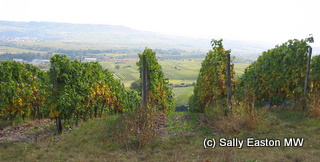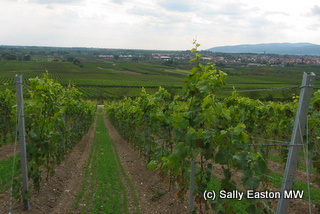Red wines from Germany
A version of this article first appeared in Fine Expressions, 2006, updated 2009.
Even in recession-hit 2009, wine exports from Germany are holding steady as the trend to fresh, refreshing, fruity wines continues to grow. It looks as though we are finally beginning to realise Germany offers fresh, unoaked styles of wine, without the massively high alcohols that can give heat to the palate rather than flavour.

Slopes are important in Germany
Germany’s heritage of producing the greatest rieslings in the world is undoubted. They used to command the highest prices in Europe. Rieslings are again going from strength to strength in the UK, and this includes the traditional styles with some residual sweetness, which are popular with the under 35s, who seem to love trying these wines without the hang-ups that some of the over 35s still seem to have. With light alcohol, these styles are ideal for lunchtime wines and for the popular gastropub culture. It seems the UK is almost the last to catch on to these light, refreshing, fruity styles of riesling.
But what few realise is that Germany also has a long heritage of producing red wines, although until recently, these were rarely found on any of the export markets. But that looks set to change. The last quarter of a century has seen some dynamic changes in the entire approach to red wine making style and quality.
PRESSING THE CHANGES
Just 30 years ago red grape varieties accounted for a little over 10% of the vineyard. Rainer Lingenfelder of his eponymous estate in the Pfalz explained: “Red wine is not new, however there was a renaissance in red wine starting in mid 1980s. I was one of the growers who wanted to revive the red wine tradition in Germany.” As he’d already worked in Australia and at Grand Puy Lacoste in Bordeaux, he was in a good position to see the potential for red German wines.
In the early 1980s, the way to make red wines was to make them like white wine. Lingenfelder said: “German reds were nothing but a coloured white. Tannins were considered undesirable; malolactic fermentation was a no-no, so a typical pinot noir had considerable acidity, a very, very light colour, and the fruit was nicely ripe for spätlese (late harvest). It would have been made in sweet style. So German reds were pale, with high acidity, some sweetness and no tannin.” To international markets these would certainly not have been a desirable option.
A handful of forward-thinking producers knew they had to make red wine differently from white. As well as colour, Lingenfelder said they needed “structure, tannin, a completely different body. The key changes were lower yields in the vineyard, a classical fermentation on skins, and a reasonably long fermentation. Malolactic fermentation to reduce the fruity acids (malic), because malic acid collides with tannic acid on palate. You can’t have both malic and tannic acids. Thirdly oak ageing.”
Lingenfelder said: “It was not the suitability of soil or lack of warmth. Pinot noir ripens properly in Baden, the Pfalz etc. It was in our minds. Having gone abroad, we could see from a different angle. So the time was just ready.”
A quarter of a century later the evidence for good quality red wines is in the bag. Within Germany, some of them are fetching Burgundy 1er cru prices. Initially the demand was so high at home there was no need to export, and there probably still isn’t, but cracking export markets add prestige and profile to a producer, especially such a hard nut to crack as the UK market, where wines from all over the world are present in abundance.

Pfalz
RED GRAPE VARIETIES
While riesling has 20% of the vineyard plantings, red grape varieties are grown on more than a third of Germany’s vineyard area. Pinot noir, called spätburgunder, is the main one, with 11% of plantings, and there has been a big increase in plantings of dornfelder, more than doubling in the last five years, to account for 8% of total plantings. Even the likes of merlot and cabernet sauvignon have appeared since the new millennium, in very small quantities, and restricted to the warmer, more southerly regions such as Baden and the Pfalz.
Pinot noir/spätburgunder: The best examples are from the Ahr, Rheingau, Pfalz, and Baden regions. Like riesling, it is a variety that is influenced by the terroir. Paul Fürst comments: “pinot noir is always a hand crafted wine. You have to work with the soil and the vine. Good pinot noir is always expensive, when you want minerality and elegance. We are always looking for low yields and thick skins on the bunch.”
Dornfelder: This is a vine crossing from the 1950s, and is a household name in Germany. It is a deeply coloured variety with good levels of acidity and an aromatic, cherry fruit profile with smooth-textured tannins. The best examples can benefit from barrel ageing which give more grip and structure. It’s easy to grow and easy to drink, generally having about 12%-12.5% alcohol.
The best reds are found in pockets all over the country, notably the Ahr, Pfalz and Baden. And Rudolf Fürst in Franken deserves special mention. Owner Paul Fürst said: “the western part of Franken is traditionally a red wine area, on red sandstone soil. The only interesting places for red wines are where you find strong soils, e.g. Ahr, Assmannshuasen in the Rheingau, parts of Pfalz and Baden. They make very different types of pinot noir. My type is strong, elegant, with wonderful colour and minerality, very long. 20 years ago we started with small barrels, and now have between 30-100% new oak.”
The small Ahr valley is the renowned red wine region of Germany, with 90% of its vineyard planted to red grapes. It is one of the most northerly regions in Europe, further north than the Mosel Valley, and it has a special microclimate that allows red grapes to ripen. Unusually, pinot noir here is planted in slate, which adds a mineral quality, fruitiness and elegance to the wines.
At the Mayer-Näkel estate in the Ahr, 80% of the winery’s production is red. Meike Näkel, who has spent time working in South Africa, explains: “we are very much in the north, but we have a very good microclimate. Our valley is narrow, the vineyards are very steep and south facing. In the narrow valley summer is hot compared to a region beside the valley. Our soil is dark slate and stone, which warms up easily. The soils conserve heat and give it back to the vines at night-time.”
They export just 5% of production which Näkel says it is a new challenge. “My father started wine in 1982, at this time German red wine was not well known. Not many producers were making good red wine and this was the challenge for him. Now export is my new challenge. ”
Part of the challenge for quality-orientated producers of red wine is that most of the best are small players. They are often run by individual families who work hard in the vineyards and cellars to make good and exciting wines. This of course means they only occasionally get abroad to promote their wines and build up a following. The onus is on wine connoisseurs sniffing out the best wines and spreading the word.
Comments
One Response to “Red wines from Germany”




June 2, 2009 at 5:53 am
da best. Keep it going! Thank you